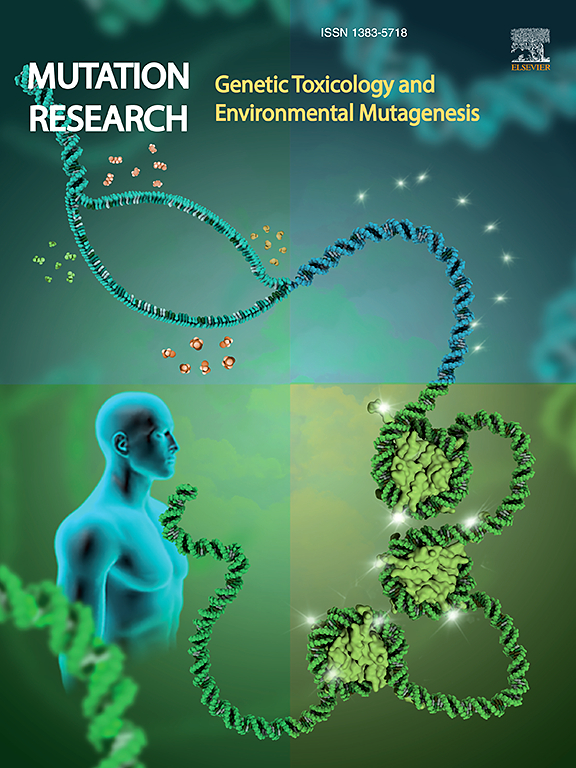Protective effects of nicotinamide mononucleotide on DNA damage and cell death in A549 cells and aging in C. elegans caused by hydrogen peroxide
IF 2.5
4区 医学
Q3 BIOTECHNOLOGY & APPLIED MICROBIOLOGY
Mutation research. Genetic toxicology and environmental mutagenesis
Pub Date : 2025-08-30
DOI:10.1016/j.mrgentox.2025.503885
引用次数: 0
Abstract
Oxidative stress is a major factor for aging. Nicotinamide mononucleotide (NMN) is a naturally occurring bioactive nucleotide and a precursor for nicotinamide adenine dinucleotide (NAD+), and accumulating evidences have shown that NMN is a promising anti-aging agent, however, the underlying molecular mechanisms remain to be elucidated. Therefore, in the current study, the protective effects of NMN on oxidative stress-induced damage to cells, in particular, the various types of cell death induced by oxidative stress, were evaluated. It was found that NMN inhibited hydrogen peroxide (H2O2)-induced decrease in A549 cell viability·H2O2-triggered reactive oxygen species (ROS) production was also diminished by NMN. Furthermore, results from 8-hydoxy 2 deoxyguanosine (8-OHdG) level, alkaline comet assay, and γ-H2AX foci formation indicated that NMN protected cells from H2O2-induced DNA damage. Detailed cell death analysis revealed that H2O2 caused A549 cell death mainly through apoptosis and ferroptosis, but not necroptosis or parthanatos, and NMN could effectively inhibit the apoptosis and ferroptosis pathways, thus protected cells from H2O2-induced cell death. Finally, we validated NMN protected against H2O2-induced organismal senescence in C. elegans. Taken together, these results suggests that NMN is a potent agent against oxidative stress, which could contribute to its anti-aging effects.
烟酰胺单核苷酸对过氧化氢致秀丽隐杆线虫A549细胞DNA损伤、细胞死亡及衰老的保护作用
氧化应激是衰老的主要因素。烟酰胺单核苷酸(NMN)是一种天然存在的生物活性核苷酸,是烟酰胺腺嘌呤二核苷酸(NAD+)的前体,越来越多的证据表明NMN是一种很有前景的抗衰老剂,但其潜在的分子机制仍有待阐明。因此,在本研究中,我们评估了NMN对氧化应激诱导的细胞损伤,特别是氧化应激诱导的各种类型的细胞死亡的保护作用。研究发现,NMN抑制过氧化氢(H2O2)诱导的A549细胞活力下降,NMN也减少H2O2引发的活性氧(ROS)的产生。此外,8-羟基2脱氧鸟苷(8-OHdG)水平、碱性彗星试验和γ-H2AX灶形成的结果表明,NMN可以保护细胞免受h2o2诱导的DNA损伤。详细的细胞死亡分析表明,H2O2主要通过凋亡和ferroptosis导致A549细胞死亡,而不是通过坏死性死亡或旁咽下,NMN可以有效抑制凋亡和ferroptosis途径,从而保护细胞免受H2O2诱导的细胞死亡。最后,我们验证了NMN对h2o2诱导的秀丽隐杆线虫的机体衰老具有保护作用。综上所述,这些结果表明NMN是一种有效的抗氧化应激剂,这可能有助于其抗衰老作用。
本文章由计算机程序翻译,如有差异,请以英文原文为准。
求助全文
约1分钟内获得全文
求助全文
来源期刊
CiteScore
3.80
自引率
5.30%
发文量
84
审稿时长
105 days
期刊介绍:
Mutation Research - Genetic Toxicology and Environmental Mutagenesis (MRGTEM) publishes papers advancing knowledge in the field of genetic toxicology. Papers are welcomed in the following areas:
New developments in genotoxicity testing of chemical agents (e.g. improvements in methodology of assay systems and interpretation of results).
Alternatives to and refinement of the use of animals in genotoxicity testing.
Nano-genotoxicology, the study of genotoxicity hazards and risks related to novel man-made nanomaterials.
Studies of epigenetic changes in relation to genotoxic effects.
The use of structure-activity relationships in predicting genotoxic effects.
The isolation and chemical characterization of novel environmental mutagens.
The measurement of genotoxic effects in human populations, when accompanied by quantitative measurements of environmental or occupational exposures.
The application of novel technologies for assessing the hazard and risks associated with genotoxic substances (e.g. OMICS or other high-throughput approaches to genotoxicity testing).
MRGTEM is now accepting submissions for a new section of the journal: Current Topics in Genotoxicity Testing, that will be dedicated to the discussion of current issues relating to design, interpretation and strategic use of genotoxicity tests. This section is envisaged to include discussions relating to the development of new international testing guidelines, but also to wider topics in the field. The evaluation of contrasting or opposing viewpoints is welcomed as long as the presentation is in accordance with the journal''s aims, scope, and policies.

 求助内容:
求助内容: 应助结果提醒方式:
应助结果提醒方式:


